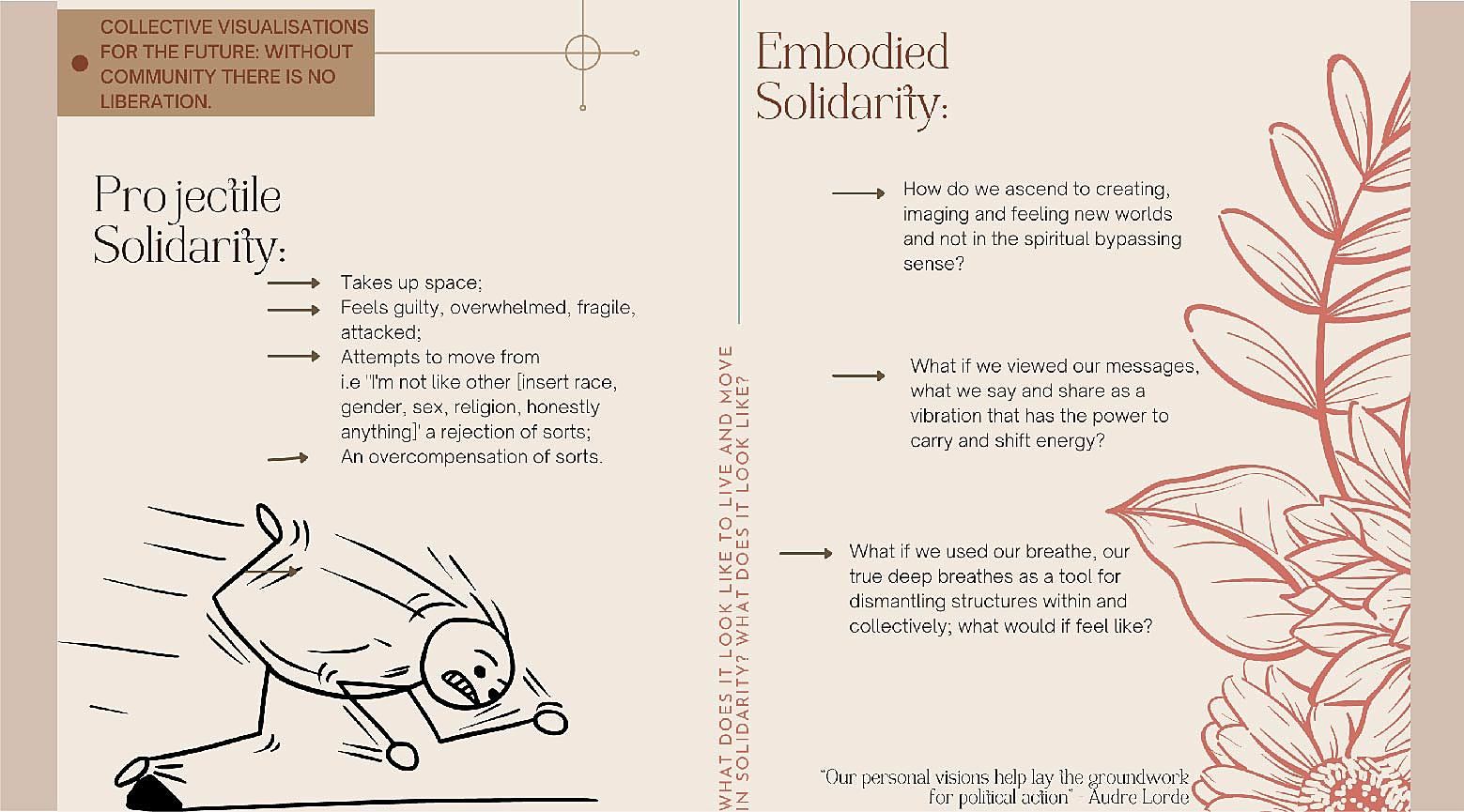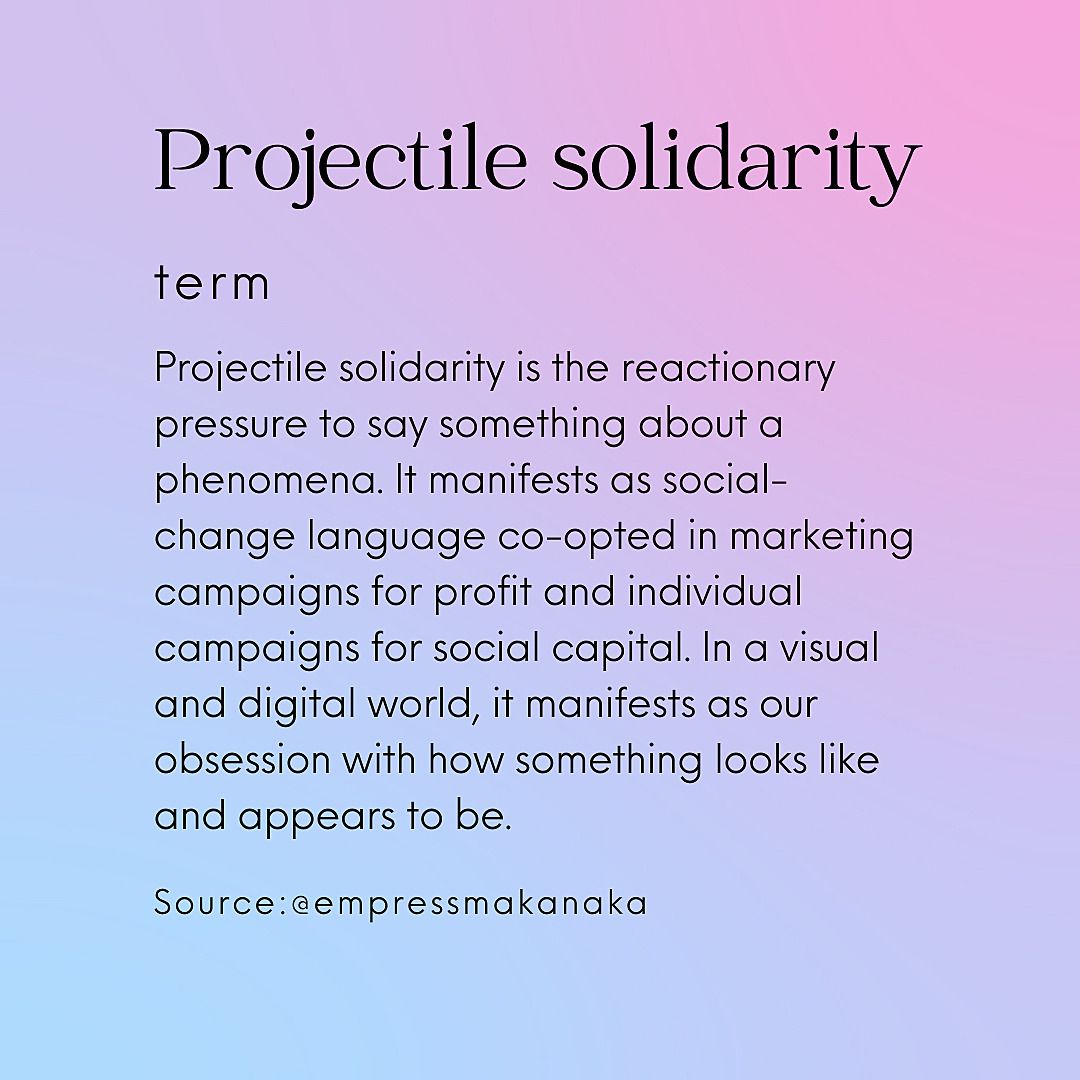Projectile Solidarity
What happens when social capital, social media and social justice collide?
I’ve always been fascinated by relationships and the ways we interact and relate to each other. While reading Joyful Militancy: Building Thriving Resistance in Toxic Times, I found the authors’ use of ‘Empire’ encapsulated some of the thoughts and feelings I was moving through. Empire is used to define the “organised destruction” we live in that attempts to render everything profitable and controllable, including our identities, relationships and desires. Before beginning the book, I had been thinking about the interactions that inform our daily experiences, what they reveal about the structures we live in and the ecosystems we contribute to. Over the years, as we’ve transitioned from Valencia filters to becoming brands of ourselves, our relationships with brands, organisations and each other have shifted.
While this isn’t about how we curate our feeds or present ourselves or the work we do, I'm interested in what these presentations and interactions mean to social justice. As somatics teacher, abolitionist and anthropologist Karine Bell posits, the essence of social justice is connection and belonging, it’s a commitment to dignity and respect for life. With everything going digital and the increased urgency and need for everything to be online, what does the inevitable self-branding mean for how we relate to each other and nurture the community?
On the one hand, brands and organisations need consumers to be aware of their corporate responsibility, stances on and contributions to societal change, or risk being called out and cancelled. On the other hand, we need each other, brands and organisations to perceive us in a particular way so we may be seen as part of something, get a job or maintain a position in society. We are forced into silos that fragment the fullness of our identities and disconnect us from the infinite realities that are possible by only mirroring some aspects of life. This is fuelled by the feedback loops in algorithms that curate a user experience that regurgitates the same perspectives, opinions and types of content, based on what you’ve already expressed interest in. There’s an illusion of proximity to access, whether it be resources, spaces, knowledge or people, that these echo chambers create.
Projectile solidarity is the reactionary pressure to say something about a phenomena
Once brand placement was about the products. Now it is increasingly about the person we are perceived to be and the people we are seen with. It fuels relations dictated by capitalistic intentions that make transactional ways of relating to each other feel inevitable. Interactions are evaluated by their value for promotion or reach, and relationships influenced by who has added promotional value. Who do we then consider worthy based on these measures?
About a year after the resurgence of the Black Lives Matter movement, global lockdowns, black squares, sensationalised breaking news and public call-outs, I’ve observed that asking the question “Did they say something?” has become almost synonymous with taking action for change. While raising awareness is important, how is the embodied experience? The turnaround time in which we’re supposed to raise awareness or have a public reaction to something doesn’t allow the time and space to engage in deep listening to the new material or realities we are confronted by. It doesn’t allow us time to process what it means for us and, most times, how we feel. It also doesn’t allow us the space needed to heal while dealing with day-to-day survival.
I think about the tarot card Nine of Wands reversed (Rider Waite deck) and how the imagery is a gentle call for balance as we move through. In this instance, it could represent the need to take a moment to explore new terrain, grounded in the lifelong learning and commitment that is solidarity.
When I was trying to pull my thoughts together about the reactionary pressure to say something, the visual that came to me was of someone stumbling home after a night out, tripping and projectile vomiting. I had drawn a stick figure with arrows coming in to indicate what was being consumed and arrows coming out to show what was being produced. I was exploring the relationship between what it feels like to move in solidarity and what it looks like to live in solidarity.
.
The guiding question of this exercise was what happens when our solidarity is informed from a place of distancing ourselves and doesn’t consider the impact on our embodied presence? I wanted to reflect on how solidarity can feel. I wanted to envision collectivity beyond what we can materially gain from each other. I guess I was pained and tired by the fact that the outrage never seemed to match the action. It felt like most efforts were a form of branding and appearing to be on the right side of history. It’s easier and quicker to make a statement than to work towards dismantling and restructuring oppressive systems.
In an Instagram post, women’s wellness entrepreneur and author Latham Thomas spoke about optical allyship as a combination of shame coupled with not wanting to look like one doesn’t know. At the core of the rupture in our connectivity and sense of belonging is shame. It fractures our relationships. As the visual of projectile vomiting sat with me, I landed on the term ‘projectile solidarity’ to speak to what I was seeing, feeling and experiencing. Projectile solidarity is born out of guerrilla theorising, a term coined by theorist and curator Neema Githere that affirms conversation as the highest form of theory. If we think about projectile vomiting and how it causes vomit to forcibly come out, projectile solidarity does the same. It is solidarity that is forcefully sent out to rid ourselves of the deep shame of our complacency.
Projectile solidarity also manifests as social-change language co-opted in marketing campaigns for profit and individual campaigns for social capital. It is a self-branding and PR exercise for brands, organisations and institutions, disregarding the relationships or lack of relationships with the communities they’re uplifting. It leaves me wondering, are we leaning deeper into people’s lives, stories and experiences as a means to an end, even when we supposedly stand in solidarity with them? We also feel a need to distance ourselves from anything potentially problematic, breeding an environment in which interactions are evaluated in terms of profit. Where perception equals dollars.
Brands and individuals use black imagery and language to align themselves with a palatable black representation
As black squares took over social networks in what was an unfortunate but great example of projectile solidarity, I reflected on how the messaging was coupled with a scramble for blackness, highlighting just how siloed and fragmented our lives are. Outside of viewing the black body and experience as something we can amplify by giving a voice to and raising awareness of, a form of entertainment or something we can save, a lot of us haven’t fostered relationships across the divides with people in our communities. Many brands and individuals use black imagery and language to align themselves with a palatable black representation – a sprinkle of Kendrick Lamar, Lizzo, Beyoncé, a black model here and an influential black friend there. This homogenisation of identities creates pigeonholes, props up caricatures and erases the depth and expansiveness of Black identity.
So often, we are identified through the elements of Blackness that can be commodified, with no regard for the distinctions between marketing activities and community initiatives. This further marginalises those directly impacted by simplifying and downplaying their experiences into narrow, one-dimensional soundbites that are supposed to holistically hold a community that spans diverse groups of peoples over continents, tribes, languages, religions and ways of life. In this way, projectile solidarity undermines representation by reducing it to optics, without exploring what it truly means to be Black in Aotearoa in 2021.
A lack of nuance around the depth of the Black experience in Aotearoa pulls us into an Americanised lens. This way of viewing and relating to our experiences removes us from any responsibility to our local communities. We hear from the same voices. The reading lists that are circulated locally on anti-blackness and resources have no context here – they are usually the same ones being circulated internationally. Instead of researching books or resources that would translate and serve to contextualise what is happening locally and globally, brands copy and paste reading lists and resources they find, add their logo to them and call this solidarity.
We should be questioning how we gatekeep platforms and take up space
We can proudly say “at least we’re not like America” and “at least we are trying”, but what about our humanity when there’s not an international crisis? What about our humanity when it doesn’t align with corporate responsibility? What about our humanity when it doesn’t align with people’s social capital? The way we learn about our value and gauge our sense of belonging is through a relational lens. Outside of these superficial symbols of social justice, how do we interact and relate with each other?
Solidarity is also presented as ‘giving a voice’ to peoples that have been minoritised when we should be questioning how we gatekeep platforms and take up space. Giving a voice to Black and Indigenous peoples for a special issue raises concerns about the lack of representation in general. If our coverage reflected our societal makeup, there wouldn’t be a need for tokenistic special issues. When this happens again (because it will), will we see a similar rush to find black creatives, black panellists and black businesses to amplify, or will our solidarity action and inclusion mean that we are actually having different conversations? For black death to be what it takes for us to be ‘included’ is to set a bar for the level of suffering we have to endure in order to be seen.
Earlier this year, I attended the online Embodied Social Justice Summit and in a presentation, somatic psychotherapist Dr Rae Johnson used the analogy of a thousand paper cuts to illustrate the impact of the manifestations of implicit bias. How we selectively support, affirm, validate, encourage, dismiss, ignore, disrespect and invade are accumulative paper cuts that are commonly minimised but deeply impactful. Within the accumulative paper cuts is an upholding of what writer, scholar and activist Amber McZeal refers to as the colonial matrix of power whereby oppression distorts our connection to land, body and others. The dynamics created from this are the sites of our devaluation. For capitalism to survive, it must exploit and prey on the unequal differentiation of human value.
In all honesty, as I continue to sit with the notion and reality of projectile solidarity, I have more questions than answers. What if we viewed our messages, what we say and share, as a vibration that has the power to carry and shift energy? To quote authors carla bergman and Nick Montgomery in Joyful Militancy, “To undo Empire’s radical monopolies entails participating in convivial forms of life: assemblages of tools, feelings, infrastructures, habits, skills, and relationships that enable and support the flourishing of creativity, autonomy, collective responsibility, and struggle”. As our differences are springboards for creativity, let’s be reminded that transformation happens in and through our relationships.


